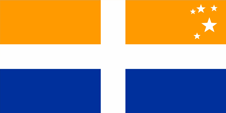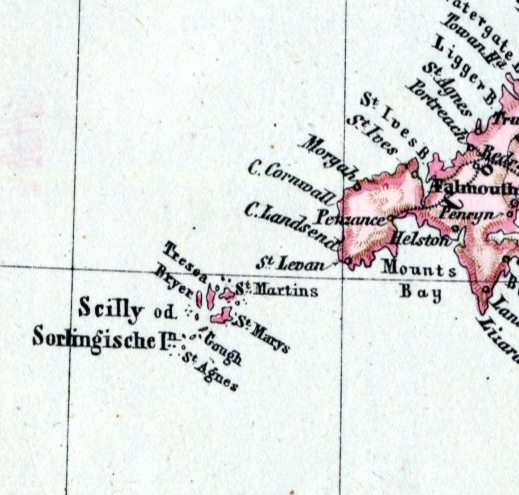Scilly-Inseln |
|
|
|
| Übersicht – Contents: | |
Diese Seite ist Teil des Projektes
Scilly-Inseln |
|
|
|
| Übersicht – Contents: | |
Flagge – Flag: |
|
 |
Flagge der Scilly-Inseln |
| Die (inoffizielle) Flagge der Scilly-Inseln wurde am 22.02.2002 angenommen. Die zeigt ein waagerecht zwischen orange und blau geteiltes Flaggentuch mit einem daraufliegenden weißen Kreuz, dessen Enden bis an den Rand der Flagge reichen. Im Obereck des wehendenden Teils der Flagge befinden sich fünf weiße fünfzackige Sterne. Sie symbolisieren die Inselgruppe. Es sind dabei nur fünf Sterne, weil nur fünf der 140 Inseln bewohnt sind. Das weiße Kreuz geht vermutlich auf das benachbarte Cornwall zurück. | The
(unofficial flag)
of the Scilly Isles was adoped on 22nd of February in 2002. It shows a
horizontally between orange and blue divided bunting with a on it lying
down white cross, its ends reach to the border of the flag. In the upper
quadrant of the flying end of the flag are situated five white five-pointed
stars. They symbolize the archipelago. They are therefore only five stars, because only five of the 140 islands are inhabited. The white cross has its roots probably in the neighbouring Cornwall. |
| Quelle/Source, nach/by: Wikipedia (EN) | |
Landkarte – Map: |
Lage – Location: Quelle/Source: Freeware, University of Texas Libraries, modyfied by: Volker Preuß |
Landkarte der Inseln: Quelle/Source: Brommes Illustrirter Hand-Atlas 1862 |
|
|
Zahlen und Fakten – Numbers and Facts: |
|
|
|
|
|
|
|
|
|
|
|
|
|
|
|
|
|
Mittelsteinzeit · erste menschliche Besiedlung 85 · zum Römischen Reich, Provinz Britannia 410 · Abzug der römischen Legionen ca. 500 · zum sächsischen Königreich Wessex 1016 · zum Königreich England 1539 · zur Grafschaft Cornwall 1642–1649 · Englischer Bürgerkrieg, die königstreue Marine zieht sich auf die Scilly-Inseln zurück 1707 · 21 Schiffe der Royal Navy verirren sich in die Klippen der Scilly-Inseln, vier der Schiffe werden beschädigt und sinken, 1.450 Seeleute sterben 1907 · der einzige Siebenmastschoner der Welt, die "Thomas W. Lawson", gerät im Sturm in die Klippen der Scilly-Inseln und sinkt 1975 · die Scilly-Inseln werden Naturschutzgebiet |
| Mesolithic
· first human settlement 85 · to the Roman Empire, province of Britannia 410 · withdrawal of the Roman legions ca. 500 · to the Saxon Kingdom of Wessex 1016 · to the Kingdom of England 1539 · to the County of Cornwall 1642–1649 · English Civil War, the royalist navy retreats to the Scilly Islands 1707 · 21 Royal Navy ships get lost in the cliffs of the Scilly Islands, four of them become damaged and sink, 1.450 seamen die 1907 · the unique seven-mast schooner in the world, the "Thomas W. Lawson", get lost during a storm in the cliffs of the Scilly Isles and sinks 1975 · the Isles of Scilly become a nature reserve |
| Quelle/Source: Atlas zur Geschichte, Wikipedia (D) |
| In der Römerzeit wurden die Inseln "Silumnus" oder "Silimnis" genannt, der volle lateinische Name der Inseln ist "Insulae Silurum". Daraus leiten sich alle anderen, auch fremdsprachlichen Namen für die Insel ab. So heißen sie auf Deutsch "Sorlingische Inseln", auf Niederländisch "Sorlings", auf Französisch "Sorlingues". In der Kornischen Sprache heißen sie "Ynysek Syllan", woraus später einfach nur "Silly" wurde. In der Englischen Sprache hatte man damit ein Problem, denn das Adjektiv "silly" heißt "albern", "dumm" oder "blöd". Uns so wurde im Englischen im 17. Jahrhundert der Buchstabe C in den Namen eingefügt. | In Roman times the islands were called "Silumnus" or "Silimnis", the full Latin name of the islands is "Insulae Silurum". All other names for the island, including those in foreign languages, are derived from this. They are called "Sorlingische Inseln" in German, "Sorlings" in Dutch, and "Sorlingues" in French. In the Cornish language they are called "Ynysek Syllan", which later became simply "Silly". In the English language there was a problem with that, because the adjective "silly" means "daft", "stupid" or "dumb". And so the letter C was added to the name in English name in the 17th century. |
| Quelle/Source: Wikipedia (D), Akademie der Kaufleute, 1755, Johann Hübners Conversations-Lexicon, 1769 | |